
|
The world of non-commercial film and A-V |
Events Diary | Search | ||
| The Film and Video Institute | | ||||
The making of The Messenger
 The Messenger won a 4-star award at BIAFF 2008
The Messenger won a 4-star award at BIAFF 2008
Norman Lilley writes about
A Teddy's War
The Messenger is the last in a trilogy of stories concerning Ted's wartime flying adventures, the production of which over the years has been something of a saga in itself for me.
The first film, Above and Beyond, was a sort of coming together of several things. I had started to write the story, in verse, as one of those things you do to amuse your child, and it grew and grew to about 90 verses. I suppose it was partly as a vicarious flying exercise (the RAF had had the pick of the country's young men for National Service aircrew in my time, and I wasn't one of them) and partly because, in doing so, I could air my knowledge of R/T (radio telegraphy) jargon, having been in Air Traffic Control in the RAF (I had managed that). The other factor was that I had always been fascinated by animation, so when I met Charlie Tyler, who was like-minded, we hit it off straight away, because I had ideas but no technical know-how, and he the latter but not the former. He also worked in film processing, and had an amateur sound studio. After a couple of tests we embarked on my 'teddy bear' verse as the nearest original material to hand.
Oh, and as a child I had been extremely fond of my teddy bear, who had worn a blue knitted jacket, which somehow worked its way into the film.
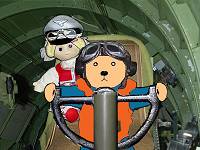 Above & Beyond was one of those types of project
that, if I had known the difficulties that lay ahead, I would probably never
have started on. But ignorance/innocence and blind enthusiasm prevailed.
Other 'cel' animators1 will know
what I mean. To start with I did not know that you could buy peg bars - I
made my own using studs set apart the width of a standard office punch, and
then punched the acetate sheets (cels) with that. Also, it was not until
I went to an exhibition of Disney original painted cels that someone there
told me that the line drawing of the characters is on the front of the cels,
but the paint is on the back. Of course, when you think about it! That means
that you can brush the paint roughly on and go over (but not beyond, of course)
the black drawn lines, and the front view is therefore always a perfectly
outlined smooth even colour. Then there were all the limitations of working
with cels - avoiding edges coming into shot if you tried to move them, waiting
for them to dry after painting, having them pick up dust, reflection under
the camera, and lots more. Anyway, I was lucky to have what I had, and the
story happened to be suitable for oft-repeated scenes - aircraft
interior/aircraft exterior alternating. So we sort of got away with it. We
had a deadline to meet when it was to be shown on stage to a live narration
by a brave actor friend. So, as time was running out, I cut about ten verses
off the end, which, luckily, turned out to give it the perfect finish point.
So luck can go with you in this medium as well as against. Another example
was when I was congratulated on the clever effect of reflection on the aircraft's
Perspex windows; actually, it was bad cel reflection. It was first shown
in 1973.
Above & Beyond was one of those types of project
that, if I had known the difficulties that lay ahead, I would probably never
have started on. But ignorance/innocence and blind enthusiasm prevailed.
Other 'cel' animators1 will know
what I mean. To start with I did not know that you could buy peg bars - I
made my own using studs set apart the width of a standard office punch, and
then punched the acetate sheets (cels) with that. Also, it was not until
I went to an exhibition of Disney original painted cels that someone there
told me that the line drawing of the characters is on the front of the cels,
but the paint is on the back. Of course, when you think about it! That means
that you can brush the paint roughly on and go over (but not beyond, of course)
the black drawn lines, and the front view is therefore always a perfectly
outlined smooth even colour. Then there were all the limitations of working
with cels - avoiding edges coming into shot if you tried to move them, waiting
for them to dry after painting, having them pick up dust, reflection under
the camera, and lots more. Anyway, I was lucky to have what I had, and the
story happened to be suitable for oft-repeated scenes - aircraft
interior/aircraft exterior alternating. So we sort of got away with it. We
had a deadline to meet when it was to be shown on stage to a live narration
by a brave actor friend. So, as time was running out, I cut about ten verses
off the end, which, luckily, turned out to give it the perfect finish point.
So luck can go with you in this medium as well as against. Another example
was when I was congratulated on the clever effect of reflection on the aircraft's
Perspex windows; actually, it was bad cel reflection. It was first shown
in 1973.
Enough of Above & Beyond, except to say that it had its day at a Cannes festival, was showed on Danish TV with a translated narrative, and was hired (and paid for) by Channel 4 for two showings in a three-year contract which they never actually screened (don't ask), and adopted as a Circle Eight Film Group2 presentation in 1985 when it won Best Film, Best Story and best Animation at that year's Surrey Film Festival. I felt it should also have got Best Natural History as it was about a bear!
Encouraged by all this fresh appreciation, I set about thinking about a follow up.
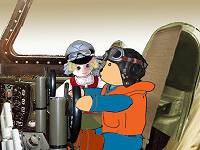 If you look on the Surrey Film-Video Festival 'best animation'
shield saying 'Norman Lilley 1986' and then '2006', you may think 'well,
he took his time'. That is true, of course, but the next stories, The
Phantom of Milford St. Giles and The Messenger, were
created quite early on. The same verse style seemed to be appropriate, and
that comes fairly easily to me. In fact the discipline of having to find
rhymes, as well as staying within the metre of the poem, can sometimes cause
things to take a more creative direction.
If you look on the Surrey Film-Video Festival 'best animation'
shield saying 'Norman Lilley 1986' and then '2006', you may think 'well,
he took his time'. That is true, of course, but the next stories, The
Phantom of Milford St. Giles and The Messenger, were
created quite early on. The same verse style seemed to be appropriate, and
that comes fairly easily to me. In fact the discipline of having to find
rhymes, as well as staying within the metre of the poem, can sometimes cause
things to take a more creative direction.
No, it was the formidable prospect of the enormity of the drawing (pencil), tracing (ink), colouring (paint), but mainly working out the sequence of pictures to create the image of fairly realistic movement with the exhausting repetition involved with such slight variations in drawn movement to accommodate a rate of about eight pictures per second of film that was so daunting.
What with all that and that awkward thing called real life interrupting all the time, these animation projects drifted off into a wilderness of impracticability.
I was lucky enough in December 1988 to retire early at the age of 54, but even in this 'free at last' situation I could not face the prospect. One further factor, which had also always been there, was whether the sequels were really worth doing.
Above & Beyond had obviously rung the bell. But would further stories be pushing things too far? I mean, "A&B" was the imposing of a fantasy over what would otherwise be a realistic enough situation - a pilot injured but perhaps conscious enough to fly back and land - and then pass out without recollection after recovery of what had happened. In The Phantom of Milford St. Giles Ted gets involved in the 'reality' of shooting down the enemy. Would this depart too far from the established spirit of "A&B"? Could I face all that energy-draining work to be met with embarrassing disappointment at the end? It was at this stage that I decided to give up. No messing, I would ever do it now. The project is stale now anyway; move on.
If at first …
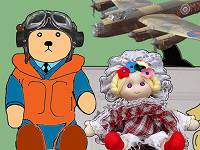 I have evolved a little rider to the adage "If at first you
don't succeed etc…", which is "… and if you still don't succeed,
give up." I will explain.
I have evolved a little rider to the adage "If at first you
don't succeed etc…", which is "… and if you still don't succeed,
give up." I will explain.
After I had retired, a friend started up a business selling equestrian things, including T-shirts and sweat-shirts with horsy jokes on the front. By chance an acquaintance had set me up with a computer and this enabled me to accept the job of creating the jokes, using the marvellous Adobe Photoshop. I beavered away in my usual slow-on-the-uptake way, and learned that you can take pictures of any size, alter their size, move them around, colour them at the touch of the mouse, make copies at a touch to keep in case you made a mistake later, and keep the components of the picture in a very high number of layers, all of which stay in perfect register until …
What? You can do what?
I probably looked like a cartoon character myself, gaping and staring in this 'eureka' moment. Suddenly before me was the answer to most of the animation problems.
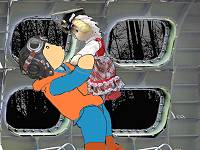 So you see, by giving up and turning to something else, I found
the answer in the 'something else'. Suddenly the sequels seemed feasible.
I still had a lot to learn, but I knew that my son, Chris, would help
me set it up. Once involved, however, his ability to manipulate Adobe Premiere
in manoeuvring my artwork became crucial, as that was something I just could
not manage. So he stays 'in'. He also narrates the verse, does all the sound
- narration, sound effects, incidental music - and is, of course, my 'first
reaction' gauge, and also has creative input on how we shove the pictures
around, speeds, distances, etc.
So you see, by giving up and turning to something else, I found
the answer in the 'something else'. Suddenly the sequels seemed feasible.
I still had a lot to learn, but I knew that my son, Chris, would help
me set it up. Once involved, however, his ability to manipulate Adobe Premiere
in manoeuvring my artwork became crucial, as that was something I just could
not manage. So he stays 'in'. He also narrates the verse, does all the sound
- narration, sound effects, incidental music - and is, of course, my 'first
reaction' gauge, and also has creative input on how we shove the pictures
around, speeds, distances, etc.
I could not possibly draw all the figures and backgrounds myself; that was not the aim. What I set out to do is make 'acceptable' pictures, using a mixture of drawing and photography (and anything else) as necessary. 'Acceptability' is, of course, like beauty, in the eye of the beholder. I could not ask for more in this respect than that the judges' very complimentary comments in the recent IAC/BIAFF competition should refer to there being a 'seamless mix' of cleanly cut drawings and photographs which did not at all detract from the style. That's beauty enough for me.
But it is a sort of compromise - this came up, oddly, in The Messenger. I could not get a decent photo shot to give me the basis of the fence where the B17 crumps its undercarriage and thought 'oh, well, I'll just have to draw it from scratch', which I did, but it took a comparatively long time. When it came for Chris to put it up on the screen, knowing nothing of this, he said 'that's a good cartoon fence'. I felt complimented, but if I had done it all like that I would still be on about verse 7.
Blowing off the dust
Anyway, going back a step, after this great gap in the wilderness and the 'giving up for good', The Phantom of Milford St. Giles was resurrected, the dust blown off it, and it was put under the critical microscope for suitability as the vehicle for the 'come-back' beckoned by this new discovery, the computer. Yes, it had the drawbacks already mentioned, but the general consensus among family and friends was that it was worth a go. It gave us the chance to feature the legendary Spitfire, and also to include the women pilots of the Air Transport Auxiliary, one of he 'forgotten' of WWII, who, it just happens, have recently been recognised with the award of a medal. No rush, then!
It was while making this that Chris pushed Adobe Premiere, basically an editing program, into the parts it probably never thought it would need to reach. But he coaxed it, pleaded with it and swore at it until it performed all the animation stunts we needed. The computer itself decided to lodge a protest towards the end of the exercise by repeatedly failing, and giving Chris a nightmare final week-end threatening total collapse with all the hours and hours of our two years-odd worth of work on it. It turned out that the motherboard had gone u/s (unserviceable) and the whole thing was only fit for scrapping after the completion of Phantom.
It was with the passable success of The Phantom of Milford St. Giles and the tricks learned on that that we embarked on The Messenger. It was generally thought, among the few who read the scripts, that Messenger was probably better in potential comic detail than Phantom. And so it turned out to be.
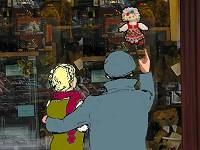 Somewhere around 1991, I was in Southport with my girlfriend
(now wife) Sandra, who was one of those who had read the script, and
we came across a stall selling rag dolls. 'How about that for the German
doll?' she said, and there, hanging up on a hook, was Heidi. She seemed
to be agreeable after a promise that I could 'get her into pictures', and
the prospect of a German Luftwaffe officer's hat sealed the deal.
Somewhere around 1991, I was in Southport with my girlfriend
(now wife) Sandra, who was one of those who had read the script, and
we came across a stall selling rag dolls. 'How about that for the German
doll?' she said, and there, hanging up on a hook, was Heidi. She seemed
to be agreeable after a promise that I could 'get her into pictures', and
the prospect of a German Luftwaffe officer's hat sealed the deal.
But now, at last, her time had come. The Messenger story was taken from a real incident in the RAF when a Lancaster bomber only just managed to lift off (through failure to re-adjust air intake settings after modification it was later discovered) but damaged the undercarriage and bomb doors in the process, and was not fit either to go on or turn back and land, so all the crew were ordered to point it in the direction of Germany and bail out. They never heard of it again. Having already 'used' the Lancaster in Above & Beyond, and to add colour, I thought to apply the idea to the U.S.A.A.F.
As in Phantom, I used a large size model of Ted that I had made from chicken wire and plaster-of-Paris, photographed him in various positions, then traced round the separate relevant parts - head, arms uniform, mae-west (life-jacket) - in black outline, then filled in the colour from the computer paint box. I left the helmet as photographed. This system is sometimes referred to, from early days, as 'rotoscoping'. Heidi was different in that I photographed her but merely outlined the whole of her. Of course, the models were not flexible enough to do all the movements I wanted; that's where I had to do a bit of artwork, helped by the 'distort' facility of the computer.
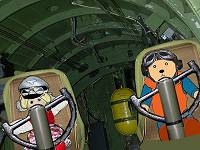 Many good sound effects are available on the internet for free,
but some we had to make ourselves. If anyone wanted some footage of what
appears to be two escaped loonies, I can recommend they follow us around
while we are trying to create sound effects. Two grown men spraying water
about in the bathroom and making 'gloopy' noises, appearing to be trying
to saw a bucket in half to get a proper squeak, drumming fingers on concrete
for a footstep effect, walking on the spot on stones, starting up various
engines - lawnmowers, hairdryers, motorbikes -, scraping a kitchen table
with a coin to resemble an old acoustic gramophone, and more. I don't recommend
that you try this at home!
Many good sound effects are available on the internet for free,
but some we had to make ourselves. If anyone wanted some footage of what
appears to be two escaped loonies, I can recommend they follow us around
while we are trying to create sound effects. Two grown men spraying water
about in the bathroom and making 'gloopy' noises, appearing to be trying
to saw a bucket in half to get a proper squeak, drumming fingers on concrete
for a footstep effect, walking on the spot on stones, starting up various
engines - lawnmowers, hairdryers, motorbikes -, scraping a kitchen table
with a coin to resemble an old acoustic gramophone, and more. I don't recommend
that you try this at home!
Finally, a word about Circle Eight, which I mentioned only briefly in this piece, but my membership of which has afforded me their vital support throughout. Being a member of Circle Eight is like being in a family, but with all the laughs and without the rows (well, mostly). I joined about 25 years ago, as a prospective acting member - the animation thing had not come up at that stage. But it was started years before that by a very young and very lean (as seen in the early films) Terence Patrick, who still leads the group and is well known in many aspects of the amateur film movement. Although film clubs often include live action and animation filming together - after all, it's all film-making - in other respects they are opposites. Live action makes people into pictures, whereas animation makes pictures into people. I left the Surrey area about 11 years ago, but remained a member. In fact, without it I would not (now living in West Sussex) be eligible to enter the Surrey festivals, and would not have entered the IAC/BIAFF at all!
- Norman Lilley
| 1 | Cels are sheets of clear plastic (originally celluloid - hence the name - and later acetate which is much less combustible) onto which the moving objects in an animated film are drawn and painted. They can be set on top of a painted or photographed background so that the drawn characters move across it. Several cels can be layered on top of one another so that different animated characters can be moved independently. Animation cels must be held in registration (i.e. steady in relation to each other) and this is usually done by punching holes in them and placing those over fixed pegs on a baseboard. Prior to computers most animation was done this way shooting each group of cels for 2 or 3 frames before making a change. Thus one second of animation would need 12 or 8 separate drawings or sets of drawings! |
| 2 | Circle Eight began in 1964 as a group of school friends making 8mm movies. It is now one of the UK's leading groups. It is remarkable for its many public screenings throughout the Southern counties and beyond. Many of their movies are available for hire - see their website: www.circle-eight.org.uk |
Share your passions.

Share your stories.